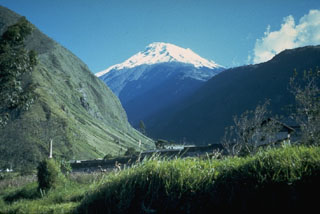Report on Tungurahua (Ecuador) — 1 August-7 August 2007
Smithsonian Institution / US Geological Survey
Weekly Volcanic Activity Report, 1 August-7 August 2007
Managing Editor: Sally Sennert.
Please cite this report as:
Global Volcanism Program, 2007. Report on Tungurahua (Ecuador) (Sennert, S, ed.). Weekly Volcanic Activity Report, 1 August-7 August 2007. Smithsonian Institution and US Geological Survey.
Tungurahua
Ecuador
1.467°S, 78.442°W; summit elev. 5023 m
All times are local (unless otherwise noted)
IG reported that on 1 August, ash-and-gas plumes from Tungurahua rose to altitudes of 5.5 km (18,000 ft) a.s.l. and drifted NW. Ashfall was reported from areas downwind. Noises indicating rolling blocks were heard. On 2 August, steam emissions and roaring noises were reported. On 5 August, roaring noises were reported and a steam-and-gas plume rose to an altitude of 5.1 km (16,700 ft) a.s.l. and drifted W. On 6 August, explosions were accompanied by roaring noises that were reported from the NW and SW sectors. A steam plume rose to an altitude of 5.2 km (17,100 ft) a.s.l. and drifted W on 7 August. Clouds occasionally inhibited visual observations.
Geological Summary. Tungurahua, a steep-sided andesitic-dacitic stratovolcano that towers more than 3 km above its northern base, is one of Ecuador's most active volcanoes. Three major edifices have been sequentially constructed since the mid-Pleistocene over a basement of metamorphic rocks. Tungurahua II was built within the past 14,000 years following the collapse of the initial edifice. Tungurahua II collapsed about 3,000 years ago and produced a large debris-avalanche deposit to the west. The modern glacier-capped stratovolcano (Tungurahua III) was constructed within the landslide scarp. Historical eruptions have all originated from the summit crater, accompanied by strong explosions and sometimes by pyroclastic flows and lava flows that reached populated areas at the volcano's base. Prior to a long-term eruption beginning in 1999 that caused the temporary evacuation of the city of Baños at the foot of the volcano, the last major eruption had occurred from 1916 to 1918, although minor activity continued until 1925.
Source: Instituto Geofísico-Escuela Politécnica Nacional (IG-EPN)

